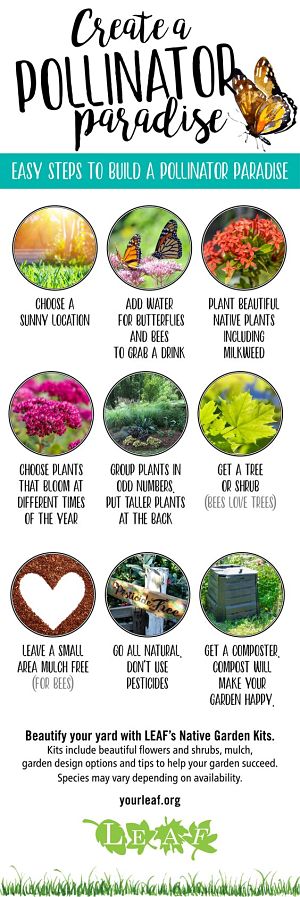Why choose native plants that bloom at different times of the year?
It’s important to remember that our gardens are more than ornamental; they host plants that are the food source for butterflies and bees. The active seasons for these pollinators vary from early spring to late fall. Having plants that bloom at different times of the year ensures there is always a ready food source! To make species selection easier, we offer garden kits that are especially designed to include perennial and shrub species that bloom at different times of the year.
Why group plants in odd numbers with tall ones in the back?
Variety and optimum location are the keys! Natural environments host diverse plants living side-by-side that provide a variety of food sources and sheltering options for the pollinators that depend on them. When designing a pollinator-friendly garden, it’s important to simulate this. What’s more, planting low growing species towards the front and larger plants behind provides pollinators easier habitat access to develop their nesting sites. To make garden design easier, all our garden kits include easy-to-follow designs that ensure plants are located in the optimum spot, aesthetically and for habitat formation!
Need more help?
We offer Native Bee and Butterfly Garden Kits to attract pollinators to your yard! These kits include a combination of native shrubs and perennials in small ($145 +HST) and large ($265 + HST) sizes that will provide a variety of pollinators with food and shelter. Garden kits are only available in the spring and include mulch, planting and care guides, species information, garden design tips and delivery.
Featured species
Below are three great pollinator-friendly species and the garden kits in which they are found.
Perennial: Hairy beardtongue (Penstemon hirsutus)
Hairy beardtongue is an early blooming perennial. Its pink-purple flowers bloom May through July and attract tricoloured bumblebees, small carpenter bees, black mason bees, and sweat bees. This plant is featured in our large native bee and large songbird garden kits.
Grass: Switchgrass (Panicum virgatum)
Switchgrass is an ornamental grass that blooms late in the season. Its flowers are pink-tinged and hover over the foliage on their panicles June through August. Apart from being the host plant for skipper butterflies, it also provides nesting habitat for bumble bees. It is featured in our large native bee kit, large butterfly and large and small songbird kits.
Shrub: Meadowsweet (Spiraea alba)
Meadowsweet is a smaller, deciduous shrub with cone-shaped flower clusters that bloom June through September. Its tiny, white flowers attract solitary mining bees, sweat bees and bumblebees. It’s also the spring azure butterfly’s host plant during its larval stage. It is featured in our small and large butterfly kits and in our small and large native bee kits. This shrub is also featured in our small yard shrub bundle or it can be purchased on its own.
In addition to garden kits, we also offer a Native Bee Shrub Bundle that includes four native shrubs (St. John’s wort, snowberry, common ninebark, and grey dogwood) great for providing food and shelter for our native bees. Shrub Bundles are available for spring and fall delivery for $100 + HST (includes mulch and delivery).
Learn more about our Native Bee, Butterfly and Songbird Garden Kits or find other ways to increase our Backyard Biodiversity.
Trees are also great for attracting pollinators! Learn more about why Bees Love Trees.
Daniela Serodio is the Marketing and Communications Coordinator at LEAF.
Thank you to the Regional Municipality of York for designing the “Create a Pollinator Paradise” infographic.
The Backyard Tree Planting Program is supported by the City of Toronto, The Regional Municipality of York, Toronto Hydro, Ontario Power Generation, The Town of Newmarket and The Town of Ajax.




